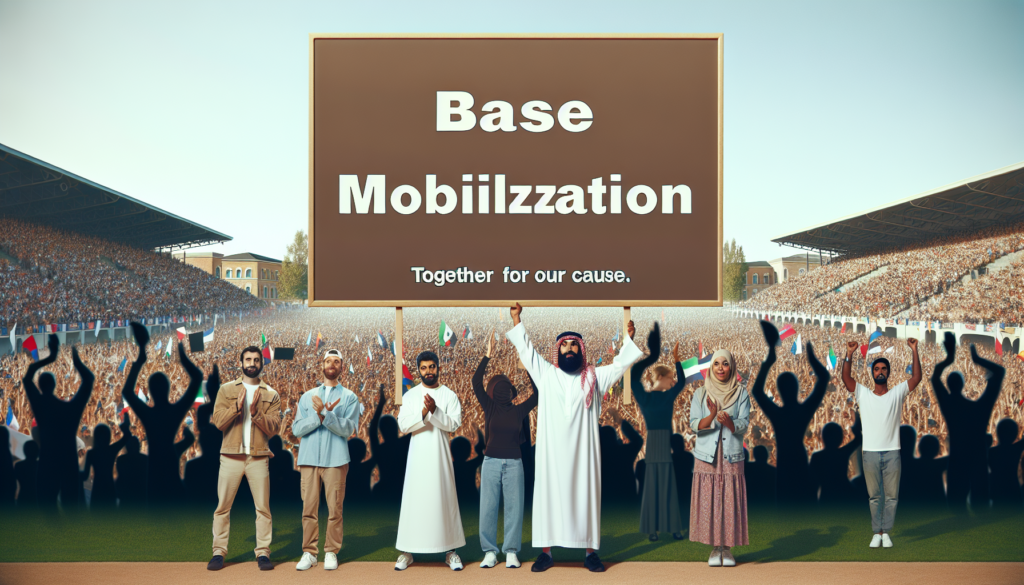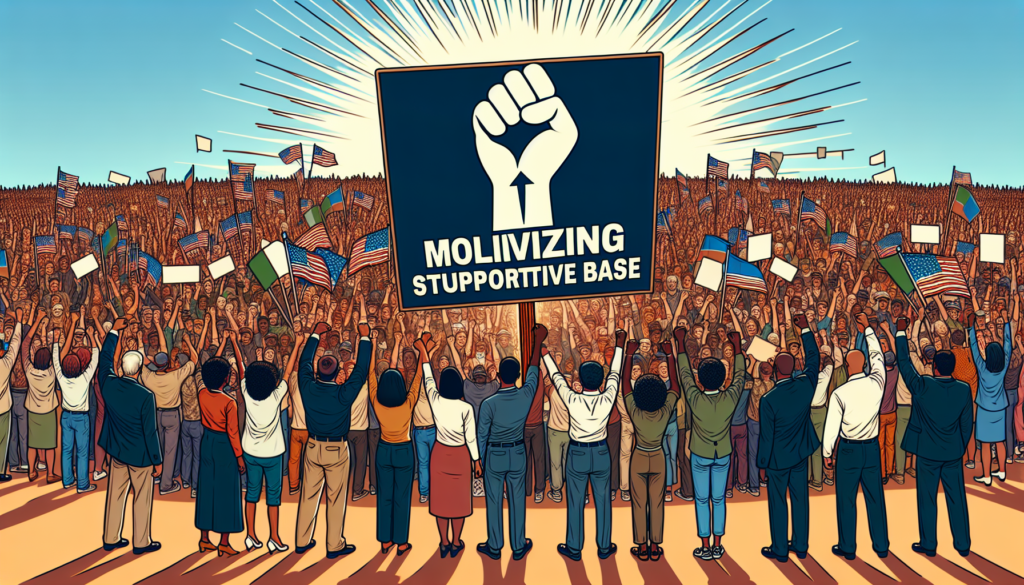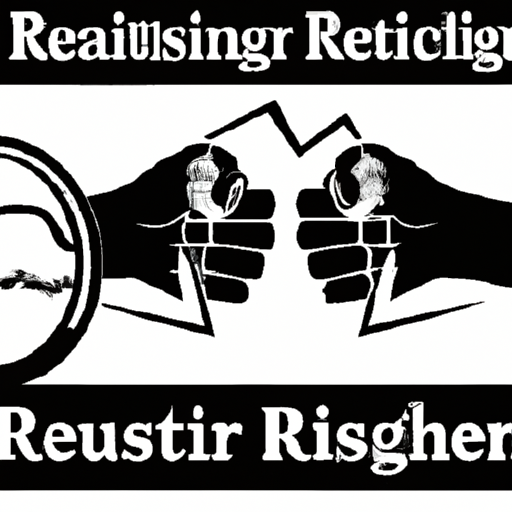If you want to rally your supporters and ensure their active participation in your cause, developing a solid strategy to mobilize your base is crucial. Whether you are running a political campaign, promoting a social cause, or organizing a community event, engaging and mobilizing your base is the key to success. By effectively connecting with your supporters, understanding their needs and interests, and providing them with meaningful opportunities to get involved, you can create a strong foundation of passionate advocates ready to champion your cause. In this article, we will explore some effective strategies for mobilizing your base and maximizing their impact.
Understanding the Importance of Mobilizing Your Base
Why Mobilizing Your Base is Crucial
Mobilizing your base is a critical aspect of any successful movement or campaign. Your “base” refers to the group of individuals who already support your cause and are passionate about it. These are the people who are most likely to take action, spread the word, and ultimately drive progress towards your goals.
By mobilizing your base, you harness the power of a motivated and engaged group of individuals who are already aligned with your values and mission. They are your strongest advocates and can serve as a driving force behind your campaign’s success. Without mobilizing your base, your efforts may lack the necessary momentum and support needed to achieve significant impact.
The Benefits of Mobilizing Your Base
Mobilizing your base offers numerous benefits that can enhance the effectiveness of your movement or campaign. By actively engaging with your base, you can:
-
Strengthen your position: Mobilizing your base enables you to build credibility and influence within your community. When you have a dedicated group of supporters behind you, you become a more formidable force and can achieve greater influence in pushing for change.
-
Expand your reach: Your base members can help you extend your message and mission beyond your inner circle. By mobilizing your base, you tap into their networks and create a ripple effect, reaching individuals who may not have been previously aware of your cause.
-
Increase your impact: The collective power of a mobilized base can be transformative. Through their collective actions, your base members can create a sense of urgency, draw attention to important issues, and drive meaningful change. Mobilizing your base amplifies the impact of your campaign, making it more likely to achieve its intended outcomes.
Identifying Your Base
Defining Your Base
Before you can effectively mobilize your base, you need to have a clear understanding of who your base is. Your base consists of those individuals who are already aligned with your cause and are likely to support your efforts. Defining your base involves identifying the demographic characteristics, shared values, and common interests that unite this group.
Ask yourself questions like:
- Who is already engaged with your cause?
- What motivates them to take action?
- What are their demographics (age, gender, location, etc.)?
- What are their shared values and beliefs?
By answering these questions, you can create a comprehensive profile of your base, which will inform your mobilization strategies moving forward.
Researching Your Base
To gain a deeper understanding of your base, conducting research is crucial. This research involves gathering data and insights about your base members to inform your mobilization efforts. There are several ways to conduct this research:
-
Surveys and questionnaires: Develop surveys and questionnaires to gather information directly from your base members. Ask about their demographics, motivations, and what actions they are willing to take to support your cause.
-
Data analysis: Analyze existing data, such as social media analytics, to gain insights into the characteristics and behaviors of your base members. Look for patterns and trends that can inform your mobilization strategies.
-
Engagement and feedback: Engage with your base members through events, meetings, and online platforms. Take the time to listen and understand their perspectives, concerns, and aspirations. This direct interaction can provide valuable insights into how to effectively mobilize your base.
By researching your base, you can tailor your mobilization strategies to resonate with your audience, maximizing your chances of success.

Developing Key Messages
Crafting Persuasive Messages
To mobilize your base effectively, you need to craft persuasive messages that resonate with them and inspire action. These messages should clearly communicate the purpose, urgency, and potential impact of your campaign. Here are some tips for crafting persuasive messages:
-
Simple and concise: Keep your messages straightforward and easy to understand. Avoid jargon or complex language that may confuse or alienate your base.
-
Appeal to emotions: Tap into the emotions and values of your base members to create a strong emotional connection. Show them how their involvement can make a difference and evoke the feelings of hope, empathy, and empowerment.
-
Demonstrate credibility: Back up your messages with evidence, facts, and testimonials to establish trust and credibility. This will help your base members feel confident in your cause and motivated to take action.
-
Call to action: Clearly state the actions you want your base members to take. Whether it’s signing a petition, attending an event, or sharing your message on social media, make it easy for them to engage and take the desired action.
Remember, persuasive messaging is essential to mobilize your base effectively. Craft your messages with care, ensuring they convey the urgency and significance of your cause.
Tailoring Messages for Specific Segments of Your Base
While your base may share common values and beliefs, they are not a homogeneous group. Within your base, there may be subgroups with unique characteristics or perspectives. Tailoring your messages to specific segments within your base can enhance your mobilization efforts. Here’s how to do it:
-
Segmentation: Divide your base into subgroups based on demographic characteristics or interests. For example, you may have a segment of younger activists or a segment of professionals in a specific industry.
-
Understand their needs: Conduct research or engage with these subgroups to understand their unique perspectives, concerns, and motivations. This will help you tailor messages that resonate with their specific needs.
-
Adapt language and tone: Adjust your messages to match the language and communication style preferred by each subgroup. This could mean using different channels or adjusting the tone to cater to their preferences.
By tailoring messages to specific segments of your base, you demonstrate that you understand and value their unique perspectives. This leads to increased engagement, active participation, and a stronger sense of community within your base.
Building Relationships with Your Base
Creating a Sense of Community
Building a sense of community within your base is crucial for mobilization. When your base members feel connected to each other and the cause, they are more likely to actively participate and advocate for your campaign. Here are some strategies to create a sense of community:
-
Regular communication: Keep your base members informed about your campaign’s progress, upcoming activities, and any news related to your cause. Regular newsletters, email updates, or social media posts can help keep them engaged and connected.
-
Encourage interaction: Foster opportunities for your base members to interact with each other, both online and offline. Create online forums or organize meetups where they can share their experiences, ideas, and resources.
-
Recognize contributions: Show gratitude and appreciation for the contributions of your base members. Highlight their achievements, acknowledge their efforts publicly, and make them feel essential to the success of your campaign.
Building a sense of community not only strengthens your base but also provides a support system for your members. It enables them to connect, collaborate, and find inspiration in the collective passion for your cause.
Establishing Trust and Rapport
Trust and rapport are essential elements for mobilizing your base successfully. When your base members trust you and your campaign, they are more likely to actively participate and become advocates for your cause. Here’s how to establish trust and rapport:
-
Transparency: Be transparent about your goals, plans, and progress. Share information openly and honestly to build trust and credibility with your base members.
-
Authenticity: Show your genuine commitment to the cause. Be consistent in your messaging and actions, aligning your behavior with the values of your base.
-
Active listening: Demonstrate that you value the opinions and feedback of your base members. Actively listen to their concerns, suggestions, and ideas, and take them into consideration when making decisions.
-
Accountability: Take responsibility for your actions and outcomes. Show that you are willing to learn from mistakes and adapt your strategies based on feedback.
Establishing trust and rapport with your base members creates a solid foundation for mobilization. It fosters a sense of loyalty and commitment, leading to increased engagement and collective action.

Utilizing Technology for Mobilization
Leveraging Social Media Platforms
In today’s digital age, social media platforms are powerful tools for mobilizing your base. They offer immediate and widespread reach, enabling you to connect with your base members, share updates, and inspire action. Here’s how to leverage social media for mobilization:
-
Identify the right platforms: Determine which social media platforms are most popular among your base members. Focus your efforts on those platforms to maximize your impact.
-
Regular posting and engagement: Maintain an active presence on social media by posting relevant content regularly. Engage with your base members by responding to comments, sharing their posts, and addressing their concerns.
-
Create shareable content: Develop content that is shareable, informative, and visually appealing. Infographics, videos, and images can help convey your message effectively and encourage your base to share it with their networks.
-
Use hashtags: Utilize hashtags relevant to your cause to increase visibility and reach a wider audience. Encourage your base members to use these hashtags when sharing your content.
By leveraging social media platforms, you can extend your reach, engage with your base members, and inspire them to take action. Social media offers a cost-effective and accessible way to mobilize your base while amplifying your campaign’s message.
Implementing Mobile Apps and Text Messaging Campaigns
Apart from social media, mobile apps and text messaging campaigns can also play a crucial role in mobilizing your base. These technologies provide direct and personalized communication channels that can enhance engagement and facilitate action. Here’s how to implement them effectively:
-
Mobile apps: Develop a mobile app specifically tailored to your campaign. This can serve as a hub for your base members to access updates, sign petitions, join events, and connect with other supporters.
-
Text messaging campaigns: Utilize text messages to deliver important updates, event reminders, and calls to action directly to your base members’ mobile phones. Ensure your messages are concise, easy to understand, and include clear instructions.
By implementing mobile apps and text messaging campaigns, you provide your base members with convenient and personalized channels to stay informed and engaged. These technologies facilitate direct communication, making it easier for your base to take action and participate actively in your campaign.
Organizing Grassroots Events
Host Volunteer Activities
Organizing volunteer activities is a powerful way to mobilize your base and strengthen their connection to your cause. By providing opportunities for your base members to take direct action, you involve them in the day-to-day operations of your campaign and cultivate a sense of ownership. Here’s how to host effective volunteer activities:
-
Identify tasks and roles: Determine the specific tasks and roles for your volunteers based on their skills, interests, and availability. Provide a range of opportunities to accommodate different preferences and abilities.
-
Create a schedule: Develop a schedule that outlines the time, date, and location of volunteer activities. Clearly communicate this information to your base members in advance to allow for planning and commitment.
-
Provide training and resources: Offer training sessions and resources to equip your volunteers with the necessary knowledge and skills to carry out their tasks effectively. This can include workshops, webinars, or volunteer manuals.
-
Recognize and reward: Acknowledge the efforts of your volunteers and show appreciation for their contributions. Celebrate milestones, highlight exceptional performances, and provide tokens of gratitude to reinforce their sense of accomplishment and commitment.
Hosting volunteer activities not only mobilizes your base members but also builds a stronger network of individuals dedicated to your cause. It fosters a sense of camaraderie, purpose, and satisfaction, leading to increased engagement and continued support.
Organize Rallies and Protests
Rallies and protests are powerful tools for mobilizing your base and creating public awareness and support for your cause. These gatherings provide visible demonstrations of solidarity, amplifying your message and attracting media attention. Here’s how to organize impactful rallies and protests:
-
Obtain necessary permissions: Research and comply with the legal requirements for organizing public gatherings in your area. Seek permits, coordinate with local authorities, and ensure the safety and security of participants.
-
Spread the word: Utilize various channels to promote your rally or protest and invite your base members to participate. Leverage social media, websites, email lists, and word-of-mouth to maximize attendance.
-
Develop an engaging program: Plan a program that includes speeches, performances, and interactive activities to captivate participants and capture media attention. Consider inviting influential speakers or partnering with like-minded organizations to enhance the impact.
-
Provide resources and support: Ensure participants have access to necessary resources, such as water, signage, and first aid. Establish designated meeting points, assign volunteers for crowd control, and communicate important information in advance.
By organizing rallies and protests, you create a platform for your base members to express their passion and commitment publicly. These events galvanize support, inspire action, and help generate momentum and visibility for your campaign.
Creating Targeted Outreach Campaigns
Identifying Key Issues and Concerns of Your Base
To effectively mobilize your base, it is essential to understand their key issues and concerns. This knowledge allows you to tailor your outreach efforts and address their specific needs. Here’s how to identify the key issues and concerns of your base:
-
Conduct surveys and focus groups: Develop surveys or host focus groups to gather feedback directly from your base members. Ask open-ended questions to understand their priorities, challenges, and the impact they hope to achieve.
-
Analyze social media conversations: Monitor social media platforms and online forums to identify recurring themes, questions, or discussions related to your cause. This can provide insights into the concerns and interests of your base members.
-
Engage with local communities: Attend local community events and engage with individuals who align with your cause. These interactions help you understand the specific issues faced by different communities and provide valuable insights.
By identifying the key issues and concerns of your base, you can tailor your outreach campaigns and communication strategies to resonate with their priorities. This enhances their connection to your cause and increases the likelihood of mobilization.
Tailoring Outreach Efforts to Address Those Concerns
Once you have identified the key issues and concerns of your base, it is crucial to tailor your outreach efforts to address them effectively. Here are some strategies to consider:
-
Develop targeted campaigns: Create campaigns that specifically address the concerns identified within your base. Craft messages, visuals, and activities that resonate with their experiences and aspirations.
-
Form alliances and partnerships: Collaborate with other organizations or influencers who have expertise in the specific areas of concern for your base members. These partnerships can lend credibility and broaden the impact of your outreach efforts.
-
Provide resources and guidance: Develop resources, educational materials, or workshops that offer practical guidance and solutions related to the concerns of your base. Empower them with knowledge and tools to take action.
By tailoring your outreach efforts to address the concerns of your base, you demonstrate your understanding of their experiences and commitment to their needs. This builds trust, strengthens rapport, and motivates them to actively participate in your campaign.
Training and Empowering Volunteers
Providing Volunteers with Necessary Resources and Training
Volunteers are a vital asset for mobilizing your base, and providing them with the necessary resources and training is essential for their success. Equipping volunteers with the knowledge and skills they need enhances their effectiveness and fosters a sense of empowerment. Here’s how to provide resources and training to your volunteers:
-
Develop comprehensive volunteer manuals: Create manuals that outline the objectives, expectations, and tasks for various volunteer roles. Include step-by-step instructions, FAQs, and relevant contact information.
-
Offer workshops and training sessions: Organize training sessions to provide volunteers with the necessary knowledge and skills specific to their roles. These sessions can cover topics such as campaign messaging, community engagement, or event management.
-
Ensure access to information: Provide volunteers with access to relevant campaign materials, guides, and resources. This can include digital libraries, online platforms, or physical resources available at campaign headquarters.
By providing volunteers with the necessary resources and training, you empower them to contribute effectively to your campaign. This enables them to represent your cause with confidence, engage with their communities, and inspire others to join the movement.
Empowering Volunteers to Become Ambassadors for Your Cause
Volunteers are not only participants but also potential ambassadors for your cause. By empowering volunteers to become advocates, you extend the reach and impact of your mobilization efforts. Here’s how to empower volunteers to become ambassadors:
-
Provide leadership opportunities: Identify volunteers who demonstrate exceptional commitment and leadership potential. Offer them opportunities to take on additional responsibilities, coordinate events, or train other volunteers.
-
Encourage knowledge sharing: Create forums or platforms for volunteers to share their experiences, best practices, and success stories. Provide opportunities for them to learn from each other and gain new perspectives.
-
Recognize achievements: Regularly acknowledge and celebrate the achievements of your volunteers. Highlight their contributions on your website, social media channels, or newsletters to publicly recognize their efforts.
-
Facilitate networking: Organize gatherings or events where volunteers can connect with like-minded individuals, community leaders, or influential organizations. These connections can inspire and motivate volunteers to amplify their advocacy.
By empowering volunteers to become ambassadors, you create a ripple effect within your base. Through their advocacy and personal networks, they can mobilize others to join your cause, expanding the reach and impact of your campaign.
Tracking and Measuring Success
Establishing Clear Metrics for Success
To gauge the success of your mobilization strategies, it is essential to establish clear metrics for evaluation. These metrics provide quantifiable benchmarks against which you can measure progress and assess the effectiveness of your efforts. Here’s how to establish clear metrics for success:
-
Define goals and objectives: Clearly articulate the goals and objectives of your campaign. Align these goals with the overall mission and desired outcomes of your movement.
-
Identify key performance indicators (KPIs): Determine the specific metrics that will indicate progress towards your goals. These metrics could include the number of new supporters, the level of engagement on social media, or the success of specific advocacy actions.
-
Set targets and timelines: Establish realistic targets and timelines for achieving your KPIs. These targets act as measurable milestones that enable you to track progress over time.
By establishing clear metrics, you create accountability and a framework for measuring the success of your mobilization efforts. Regular monitoring of these metrics enables you to identify areas of improvement, refine strategies, and celebrate achievements.
Using Analytics Tools to Monitor Progress
Analytics tools provide valuable insights into the effectiveness of your mobilization strategies. These tools provide detailed data and analytics that enable you to track progress, identify trends, and make data-driven decisions. Here are some analytics tools to consider for monitoring progress:
-
Social media analytics: Platforms like Facebook Insights, Twitter Analytics, and Instagram Insights provide data on engagement, reach, and audience demographics. These insights can inform your social media strategies.
-
Website analytics: Tools like Google Analytics track website traffic, page views, and user behavior. This data helps you understand user engagement and optimize your website for better mobilization outcomes.
-
Email marketing analytics: Email marketing platforms such as Mailchimp or Constant Contact offer analytics on open rates, click-through rates, and engagement. These insights help you assess the effectiveness of your email campaigns.
-
Event attendance tracking: If you organize events, utilize tools like event management software or ticketing systems to track attendance, collect feedback, and measure participant satisfaction.
By leveraging analytics tools, you gain a deeper understanding of the impact of your mobilization strategies. These insights enable you to make data-driven adjustments, refine your approaches, and optimize your mobilization efforts.
Adapting and Refining Strategies
Continuously Assessing and Adapting Your Mobilization Strategies
Mobilization is an ongoing process that requires constant assessment and adaptation. As your campaign progresses, it is essential to evaluate the effectiveness of your strategies and make necessary adjustments. Here’s how to continuously assess and adapt your mobilization strategies:
-
Regular evaluation: Routinely evaluate the effectiveness of your mobilization efforts based on established metrics and KPIs. Determine what is working well and what needs improvement.
-
Collect feedback: Engage with your base members, volunteers, and supporters to gather feedback on their experiences and perceptions. This feedback can provide valuable insights and highlight areas where adjustments are needed.
-
Monitor trends and external factors: Stay informed about changes in your community, political landscape, or social climate that could impact your mobilization strategies. Adapt your approaches accordingly to align with new realities.
-
Experiment with new tactics: Be open to trying new tactics, platforms, or communication channels. Experimentation allows you to discover strategies that might be more effective in mobilizing your base.
Adapting and refining your mobilization strategies based on feedback and results is essential for maintaining relevance, maximizing impact, and sustaining momentum. Embrace a mindset of continuous improvement as you work towards your campaign’s goals.













